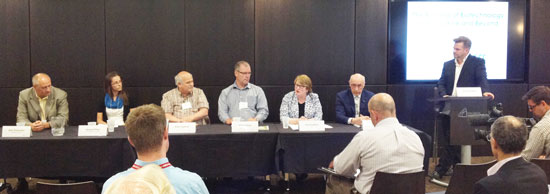 Picture this
Picture this
A Saskatchewan farmer uses microbial inoculants and biostimulants (microorganisms that promote plant growth and health) instead of the agrochemicals that are traditionally used on her crops to give them a strong start and protect them through to harvest. Her farm’s healthy and robust crops of pulses, grains and oilseeds are used in Canada and around the world to feed its growing population.
Saskatchewan’s biotechnology cluster
Our farmer’s deliberate use of microbes on her crops is just one example of how commercialized biotechnology is being implemented in Saskatchewan. Almost 30 years ago, the Government of Saskatchewan recognized that developments in science and technology would lead to major changes in the province’s agriculture industry. They created world-class research infrastructure and industrial support organizations to catalyze the growth of an ag-bioscience cluster in Saskatchewan.
Last week, I moderated a panel of biotechnology leaders from Saskatchewan’s growing biotechnology cluster. Hosted by Saskatchewan Research Council (SRC), Ag-West Bio and Innovation Place, the forum attracted more than 70 professionals. From the discussions and anecdotes shared by our esteemed panelists – Wilf Keller, Ag-West Bio; Denise LeBlanc, Aquatic and Crop Resource Development, NRC; Mike Crabtree, SRC’s Energy Division; Dean Chapman, Canadian Light Source; Vanessa Pittet, Contango Strategies; and Reno Pontarollo, Genome Prairie – it’s evident Saskatchewan is a global leader in agricultural biotechnology. Whether it’s increasing crop yield and stress resilience (as in our story above), accelerating new variety development or improving livestock production and sustainability, we have embraced biotechnology to deliver more value to the agriculture sector and enhance food security on a global scale.
Biotech beyond agriculture
Now our collective and foundational strengths in agricultural biotechnology have given rise to opportunities to apply these leading-edge capabilities in other areas as well. The objective of last week’s forum was to identify and share our perspectives on emerging opportunities for biotechnology in Saskatchewan and to explore how we work collaboratively to drive innovation by leveraging our respective and mutual core strengths.
The discussion was lively; the topic prompted questions from the floor about small and medium-sized enterprises (SMEs), funding opportunities, balancing basic and applied research, as well as innovation and biotechnology opportunities in other sectors – beyond agriculture.
The same day as our event, Genome Canada launched a new funding opportunity – a large-scale applied research project competition for natural resources and the environment; the scope of which includes areas such as genomics research related to energy, mining, forestry, water stewardship, wildlife management and conservation and bio-products that help conserve natural resources and protect the environment.
The discussions touched on a need for a greater balance in bioscience funding priorities and organizational mandates for supporting SMEs. The Canadian Light Source, for example, has a focus on commercial partnerships with industry, with a target of 25 per cent industrial usage.
The conversation helped open the door for a greater understanding of the vast capabilities throughout the cluster and opportunities for further collaborations.
So what’s next?
I envision follow-up discussions and presentations in the months and years to come, focusing on entrepreneurship, biotech in the mining and energy sectors, environmental bioremediation and more. SRC looks forward to engaging various communities and sectors in honest dialogue about the future of Saskatchewan’s biotechnology cluster.
Now picture this
Local scientists meet with a mining client to design wetlands and explore microbial capabilities to remediate a mine site. At this same site, uranium has been leached from low-grade ore, waste rock and mine tailings using economically viable and environmentally friendly biotechnology discovered by SRC researchers.
Some of these life science solutions are already in use today – and we aren’t too far off from having this new story become the norm. These technologies are being developed and commercialized in a thriving biotechnology science cluster right here in Saskatchewan.
This post originally appeared on SRC’s blog about science and technology, From the Lab to the Loading Dock. Read more SRC blogs
Phil Stephan is SRC’s Vice-President of Strategic Initiatives. He previously served as a Business Unit Manager for SRC’s crop testing lab and managed global business development at SemBioSys Genetics Inc. In addition to corporate management and leadership, he holds undergraduate and graduate degrees in agricultural biotechnology and biomedical technology.
